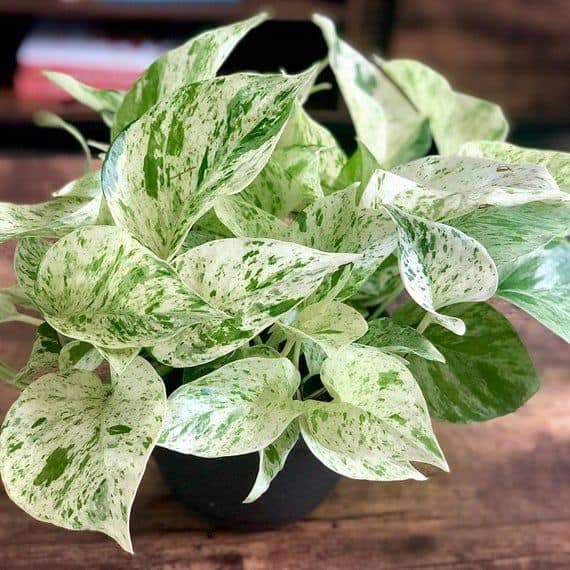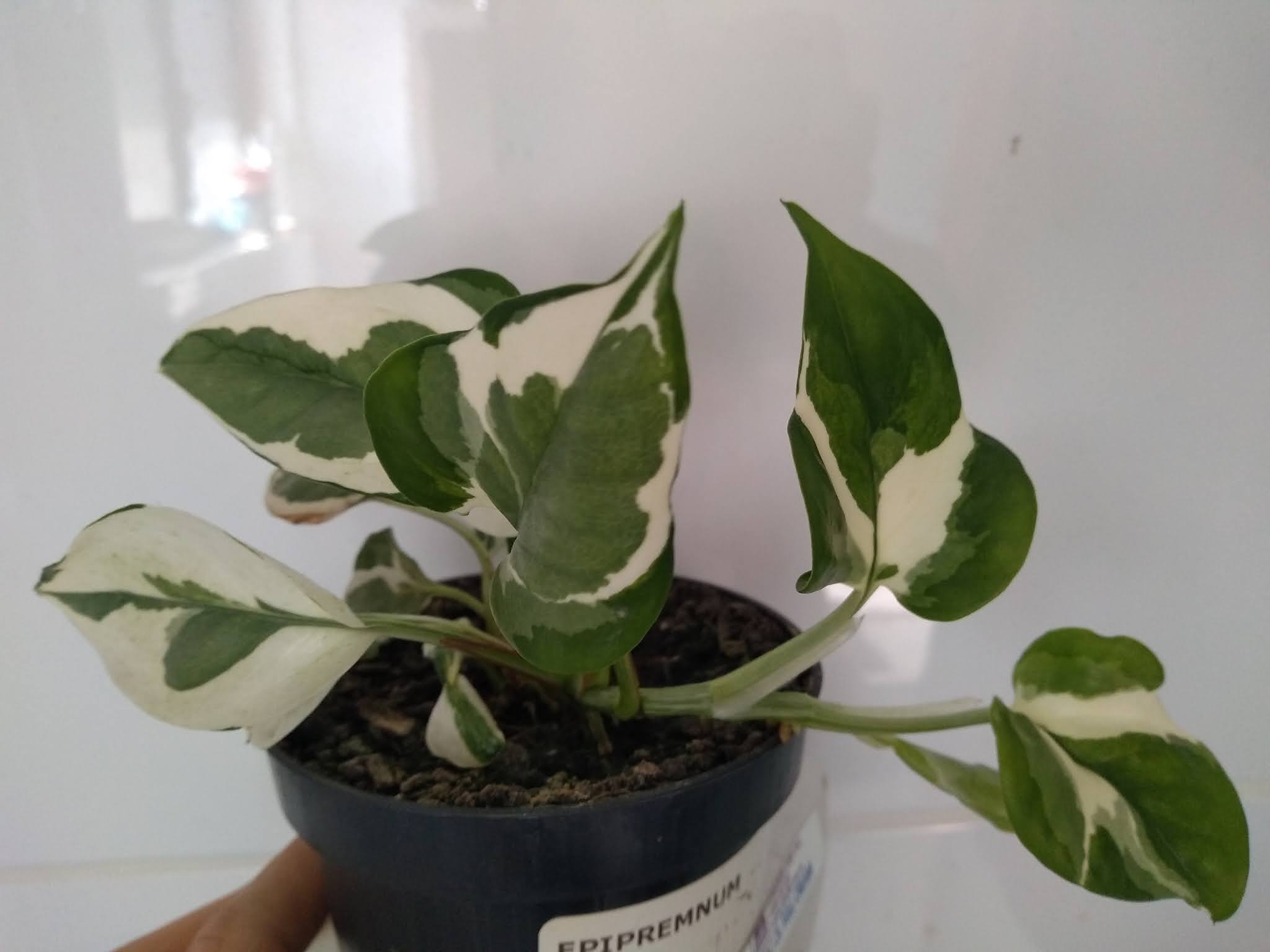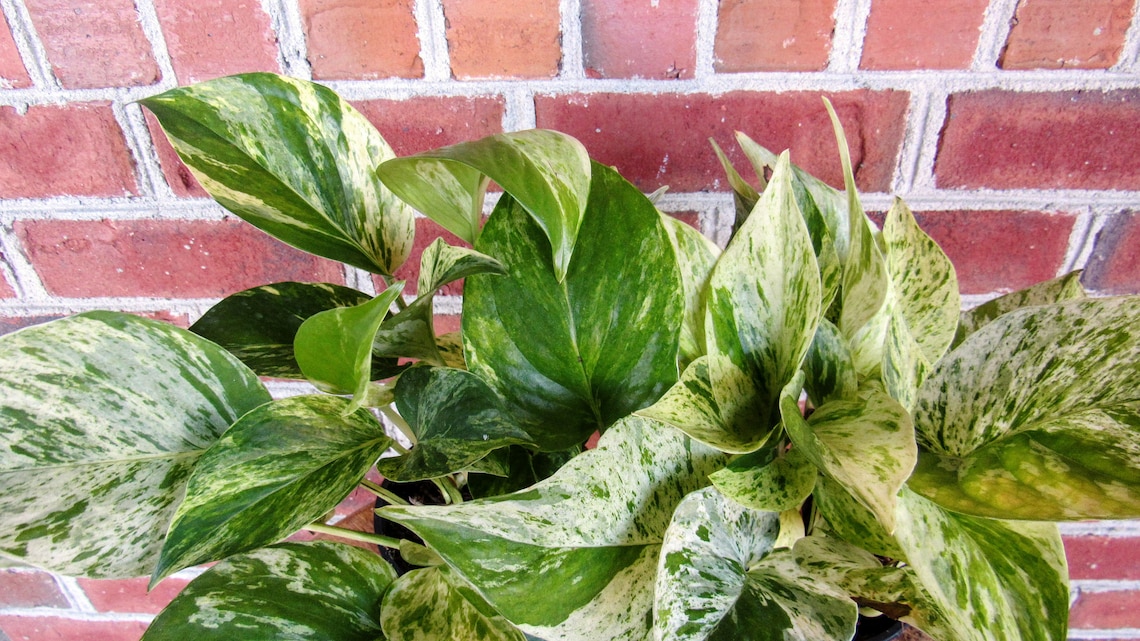Pothos are the most common houseplants; they can be table or hanging plants. The snow queen pothos plant which is scientifically known as Epipremnum aureum is simple to grow, take care of, and even thrive in poor growing environment. The foliage colors are clean white variegation with very dark green base color on the leaves.
The pothos plant varieties are many and the plant is grown all over the world. The most common variety of the pothos families are snow queen pothos, golden pothos and marble queen pothos.
Now let’s look at the snow queen pothos in detail: growing tips, care tips, issues that may arise with them and how to solve them.
What Is Snow Queen Pothos?

In taxonomic categorization Pothos is classified a member of the family tribe potheae of flowering plants. It is a natural creeper plant suitable for the indoors with white marveling texture and bright green foliage. It can be transplanted to a container or hanging baskets and then be placed on a dining table or living room.
They are good air purification plants which will assist in maintaining quality air indoors, so the snow queen pothos is an ideal plant. They will also aid in taking away any smells which are undesirable within a room. The pothos will also help relieve eye irritation which is caused by staring.
With that basic understanding of snow queen pothos, it is now possible to look at how to plant and propagate this plant.
How To Plant Or Propagate Snow Queen Pothos Plants?

Image Credit: living-mudflower.blogspot.com
This plant is fairly simple to propagate and can be purchased at almost any garden store or nursery as the pothos snow queen plants. The other technique in propagation of snow queen is cuttings.
It is important that you should have a healthy plant; ensure that the tools you will be using for the exercise are cleaned. We have prepared some tips that you could use to ensure that you have a healthy plant:
Step 1
The first thing to consider before using any of the tools is therefore to clean and disinfect them. Next you pick a robust-looking shoot and trim it down to just half an inch below a node. When selecting the shoot, it has to be a four to six inches long and containing several sets of leaves. Ensure that you cut.
Step 2
The second step is optional but recommended. Ideally, you must use a rooting hormone powder at the tips of the cutting to get the process started. You could decide to use Garden Safe Brand TakeRoot Rooting Hormone since this one is super effective for new root growth just from cutting.
Step 3
The third step is to put the cutting in a blow with some fresh water. Then you will transfer the bowl to a location that they can offer bright indirect light. Bear in mind that in the event you exposed the plant to direct sunlight it is likely that the leaves will burn or the roots become dehydrated.
Step 4
Finally, you have to watch and wait if the plant grows or not. It should only take three days to a week for the pothos roots to sprout again. This features then imply that it is time to transplant the plant. As with other plants that are planted in gardens, this plant can be planted in a direct manner, or you could plant it in a raised container or any indoor garden or even a container if you are intending to be indoors.
If you are planting it in a container the best thing to do is to repot in a small pot or container with fresh soil as the pothos family thrive in root constrains. Also, the planting soil should also contain the following; organic compost, peat moss and perlite.
Basic Snow Queen Pothos Care Instructions

Image Credit: reddit.com
1. Propagation
Now, as we had mentioned above, the propagation of snow queen pothos is extremely easy if done correctly. This means that to enhance the smooth flow of the process your tools must be clean. Perhaps, more important is to avoid worrying about trimming the stems in the mother plant as new growths will sprout from the node.
What this is implying, is that the growth of the mother will not be affected. Pruning the mother plant frequently will promote new life or growth and you can have a bushier plant.
2. Potting And Repotting
When potting the snow queen pothos, make sure that your pot or container you use has multiple holes on the bottom. Also you don’t have to fertilize frequently because the snow queen pothos prefers to be root bound.
But there is one you must attend to, no loose soil if you are to report. Also, the reporting will enhance the nutrient in the soil and there will be an excellent aeration of the great soils.
3. Soil
With proper care, the snow queen pothos will be bushy or up to 6-10 feet long. It is possible to use any good quality soils for planting a pothos plant as far as the soil is fast draining. Ensure the soil is always moist and in specific areas which maneuver wet the root may rot. Another requirement of your plant that fades during winter is watering, this will be required more often during summer than in winter.
Other condition that has to be created include the fact that the pH of the soil has to be between 6.1 and 6.5. perlite, peat moss or organic fertilizer into fresh potting mix to ensure you get a good growth base. However, you may choose to buy the finest potting soil, such as Nature’s Care Organic Potting Mix which will ease your work.
4. Fertilizer
Pothos care is rather affordable and does not require much little fertilizing to grow the snow queen variety. In fact, it is recommended that you neither add any additional fertilizers for the growth of the plant. But if you intend to use fertilizers you can use the organic kind of fertilizers. For instance, you can use proper feeds such as seaweed solution and worm castings.
5. Light
The pothos plant will equally grow well in the indirect lights or the partial lights. But, of course, you should be aware that the plants will also function in low light situation, they should prefer damp ground and indirect sunshine. It is all right to expose a few hours to direct sunlight; you should not expostulate them to direct sunlight for the whole day.
6. Humid Conditions
Ideally, the right humidity level for a pothos plant should be 50%- 75 %. The plants will grow well in warm climates of tropical or subtropical zones but if your area is dry then you can always keep the plant well watered. But, it would be best not to pour water all over the leaves as this tends to encourage the growth of fungi.
Problems You May Encounter With The Snow Queen Pothos Plants

Image Credit: plantsinabox.com.au
Just as it is with most varieties of pothos, the snow queen pothos plant will encounter problems relating to diseases, pestilence, and other competitive plants. We will assess the critical issues you are likely to face with these plants and how you are likely to handle it.
1. Mealybugs And Thrips
Mealy bugs and thrips are the most typical forms of pests that are found during treating the snow queen pothos plants. They are pests that you can control using horticultural oil, soap or neem oil.
2. Dust
Often, regardless of the pothos are outdoor or indoor plants, they gather dust most of the time. Hence you have to clean the leave often. This will assist with the look but it will assist in the photosynthesis.
3. Root Rot
Another common problem which you may come across is root rot. It is mainly found when the plant is overwatered and there is an attack of fungal pathogens on the roots. The best way to minimize risk of root rot is to ensure good drainage of the soil used and to ensure that the pot used has holes at its base.
How To Know If Snow Queen Pothos Have Root Rot?

Image credit: plantcaretoday.com
Pothos plants are also known to develop root rot disease, a common disease affecting many plants. If not detected and addressed in good time, the problem is likely to affect the whole plant. Especially the root rot produces a white and green color changing to black or dark brown. However the stem and the leaf veins will not even turn brown or black as a result of root rot.
If you want to know and be certain that your plant is sick it seems weak at first and then starts to produce discolored leaves which could be brown or black and the next thing, the entire plant dries up or even dies. But it really gives an indication of rot that you will be able to treat it and revive the pothos plant.
In practice, the only solution to eliminate rot is to watch that the substrate drains well and that the pot has drainage holes at the base. If it has already set in, you might use a fungicide to contain the rot and prevent it from spreading through the plant.
What Is The Difference Between Snow Queen And Marble Queen Pothos?

Image Credit: etsy.com
The propagating snow queen pothos and marble queen pothos has several similarities than it has differences. To begin with they both grown in places such as indoors and their leaves are of the same size. This type may have small leaves if grown in a container, while if they are planted on an outdoor ground covering, they can grow quite wide. Also they have similar drawings at their heart shaped leaves. Also, snow queen and marble queen pothos care are simple.
We will list some of the main differences between the two plants:
-
- The Marble Queen Pothos has larger leaves than the Snow Queen Pothos, and the tips of the Snow Queen Pothos leaves are inclined to be more acute.
- The Snow Queen pathos have more tissues with even lesser chlorophyll – they are therefore less green than the marble pathos. For this reason, the snow queen pothos, develops in varying degree 70 to 80 % white and 20 to 30% green, the marble queen pothos is 50 % white and 50% green.
- The snow queen takes a little longer to grow than the marble queen pothos. Although the snow pothos has larger portion of chlorophyll-free tissue, it will grow less compared to the marble queen pothos.
- The snow queen pothos is exactly the same size as the marble queen pothos but it grows slower.
- Another difference from the marble queen pothos is the snow queen pothos and the latter can easily be affected by fungi. This way, with the snow queen pothos care, you need to pay more attention than the marble queen pothos care, but both types require the best care.
- The marble queen pothos is an indoor plant but it requires planting in a big pot or any kind of containers as compared to the Snow Queen pothos which needs more soil than what the marble queen pothos has.
- The lighting requirement in these two plants may vary depending on what you want to get out of the plant. The snow queen pothos doesn’t have to be exposed to intense sunlight but the marble queen will need more light excluding sunlight.
- The other major difference is that this variety requires more water as compared to the red rose. To care for the snow queen pothos, you need a small pot with good drainage to avoid root rot while the marble queen pothos are water hungry, specially during the growing period.
The marble is known by its common name snow queen pothos and it looks more like the variegated monstera but it needs more fertilizers. You does not have to apply fertilizer to the snow queen, but feel free to use some all the same. But marble queen will require much more fertilizer to make it greener and to maintain the healthy growth of the plant.
Frequently Asked Questions About The Snow Queen Pothos
1. Is Snow Queen Pothos Toxic To Pets?
Yes, snow queen pothos can be toxic to your pets and includes cats and dogs. Besides, if the pets chew the leaves or stem, they may have problems some times. In this case, if you have pets around the house you can get a plant that does not pose any harm to the pets.
First, however, you might want to try moving the pothos plant out of reach of the pets. Then, if your pets eat the plant, you should consult a veterinarian.
2. Why Does Snow Queen Pothos Turn Brown?
The primary reason why snow queen pothos turn brown is because of root rot. This is mainly due to lots of water infections on the rotting. Some other problems that lead to the browning of the snow queen leaves include under watering, exposure to too much light and other disease affecting the leaves.
Again the same problem of too much fertilizer or water brings brown spots or even tips of the leaves turn brown. If you want to keep your plant healthy or fix brown spots and tips, wait for the soil to get dry before you give it some water. Also, avoid direct light.
3. Does Pothos Grow Faster In Water Or Soil?
The pothos plant grows much faster in soil since the soil has everything that the pothos snow queen requires for growth. There is self evident and complementary truth that healthy soil will produce healthy and vigorous plant. The soil moisture also favours : fast-growing for the snow queen types of pothos.
4. What is the Difference between Pothos Marble Queen and Snow Queen?
There are two varieties of Pothos Marble Queen and Snow Queen, both being the Epipremnum aureum snow queen plant. But in terms of appearance, they are not completely identical here are the difference: As for the difference between Marble Queen and Snow Queen, this is that the latter type has a different shade of green and patterns of variegation.
Marble Queen has dolled up big green leaves having creamy white patches resembling marble whereas the Snow Queen has significantly small, compact leaves of white green coloration. It also has a more dramatic effect, which gives it a better appearance altogether.
The Snow Queen also has less leaf area and can be even more bushy than the Marble Queen. As for the care, both varieties are alike, and they will appreciate moderate to bright indirect light and a correct draining soil.
5. How much Light does a Snow Queen Pothos Plant Need?
Pothos plants and more so the Snow Queen pothos can grow in different light intensities since they are invasive plants. But the Snow Queen Pothos requires bright, indirect light to grown at its best with distinct leaves variegation.
You should place the plant near a window that receives indirect light because the strong sunlight will burn the leaves. In a condition of low light, the variegated regions of the foliage may lose their color, and the growth could become more spread out.
In case most of the leaves turn yellow or brown it may be a signal of over lighting and consider moving it to a less lit area.














